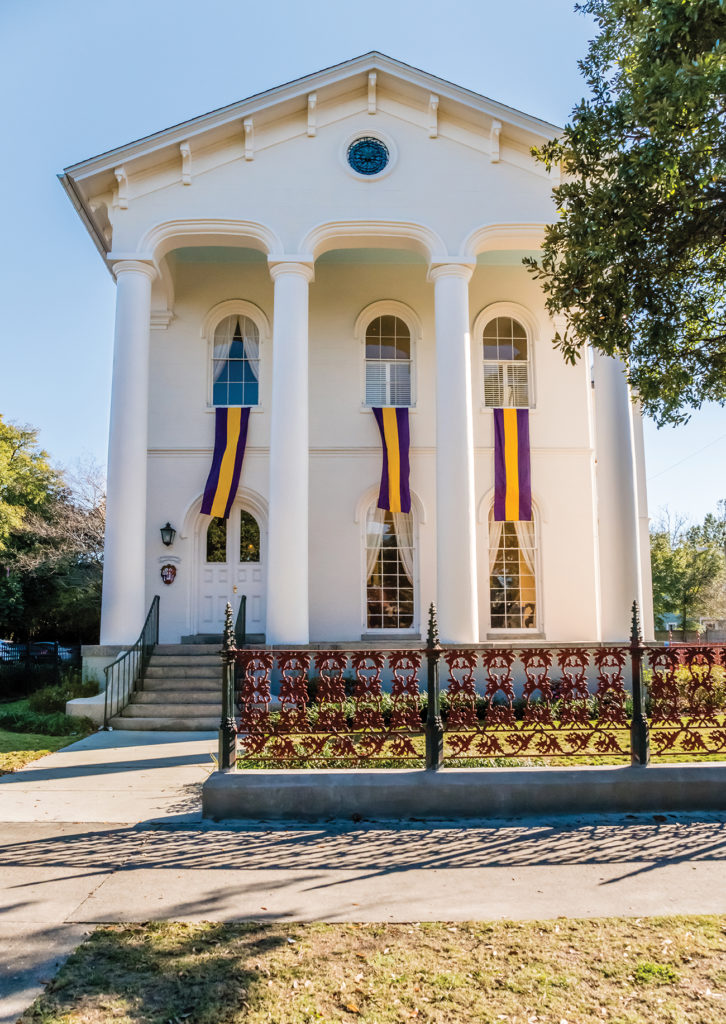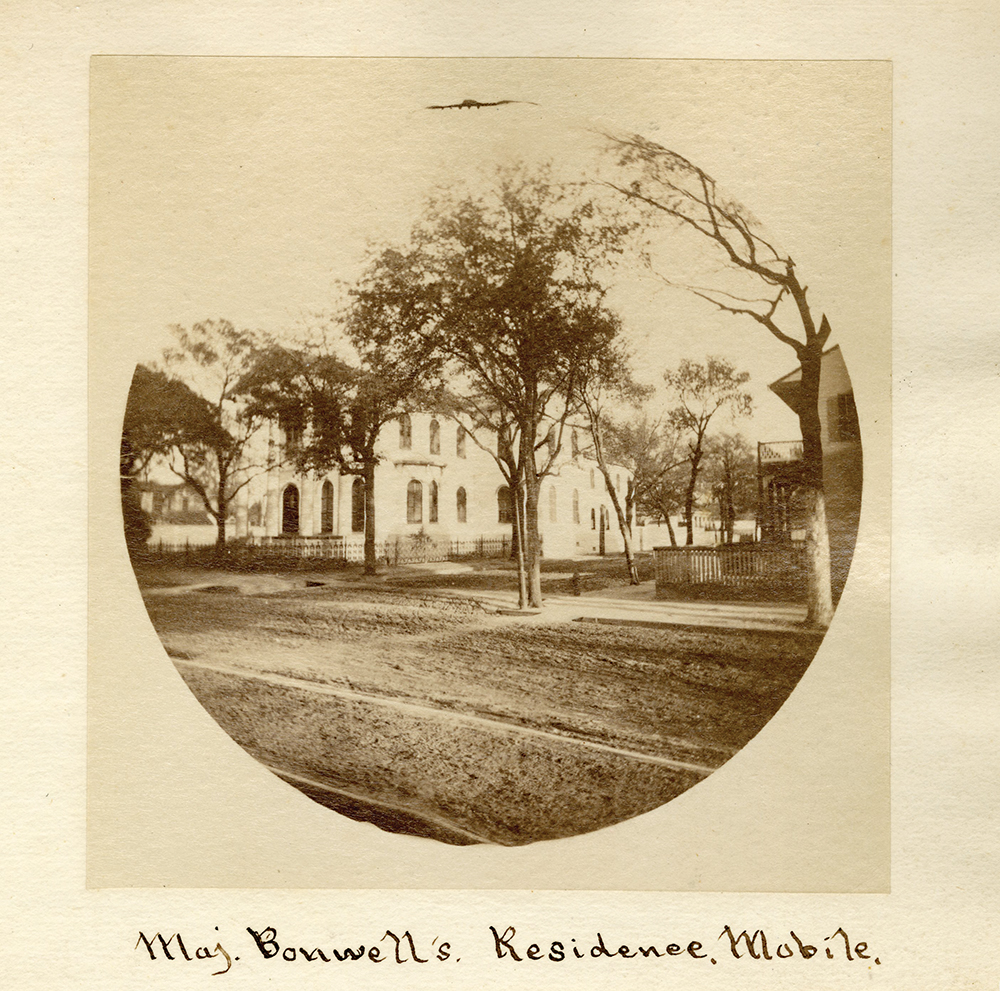

Last fall, the 1857 Foundation, a 501(c)(3) nonprofit corporation, completed its full restoration of the Joshua Kennedy Jr. home, located in the Church Street East historic neighborhood of downtown Mobile at 607 Government Street. Restoration efforts by the foundation began in May 2017 with a group of concerned local business professionals who collectively saw a need to save the structure from its imminent demise. Leaks, structural decay, a vagrant’s fire and general disrepair were some of the causes of the building’s perilous state.
“The Kennedy House is one of the only surviving colonnades along that section of Government Street from the first golden age of Mobile,” says James Alexander, president of the 1857 Foundation. “We quickly realized this project was bigger than we were. We felt a responsibility to properly restore and save this part of Mobile’s heritage. Great lengths were taken not to cut corners.”
To that point, the plaster walls and crown molding were fully restored. All the windows were removed, cleaned and refurbished by Oakleigh Restoration and the home’s original glass was carefully reinstalled on the front of the house. “We were fortunate to have a talented group of local, civic-minded professionals willing to donate their time, energy and resources to ensure our restoration efforts were successful. A number of local architects, engineers, bankers, attorneys, contractors and real estate professionals used their expertise to make the restoration a reality,” says Thad Hendrix, a local engineer and member of the foundation board.
The house, which is considered a transition between the Greek Revival and Italianate styles, features 14-foot ceilings, seven fireplaces, a beautiful bay window, arched windows and doors, and the original sweeping staircase, right, along a plaster radius wall in the grand hallway.
This restoration would not have been possible without a tenant that shared the foundation’s vision of preserving and properly maintaining this historic Mobile landmark. “With that goal in mind, we entered into a long-term lease with a prominent, local Mardi Gras society that will use the property for membership meetings and special events,” Alexander continues. “Mystic societies are a very important part of the fabric of Mobile. They make meaningful, ongoing contributions to our local culture and economy. Anyone looking for an example of this significant impact need look no further than the newly restored Kennedy House.”


The home was first listed on the Alabama Trust for Historic Preservation’s “Places in Peril” list in 2003. Members of the foundation board went to lengths personally to find fitting architectural details to replace what had, over time, been lost or destroyed. Two converted upstairs bedrooms, now called the President’s Room, are used for board and other committee meetings. The room boasts twin triple cartouche mantelpieces of pink plantation marble. “When we found them in St. Louis, they were in a million pieces and laying up against the wall of this guy’s garage. They still had mortar attached to them and looked a mess. The guy said, ‘I’ll give them both to you for $750,’ and we said, ‘sold!’ We loaded the marble up in our vehicle and drove them 700 miles back to Mobile. The shocks were never the same, and we sold the car a month later,” Alexander says.
Delta Stone restored the mantelpieces. Because they had numbers and letters on the back, they were put back together like a jigsaw puzzle. “They are not inconsistent with what you’d find in downtown Mobile, they’re just pink.”

Joshua Jr. amassed a comfortable fortune in the wholesale grocery trade. He used profits to construct the Government Street residence in 1857. The facade of the home features an unusual full height portico that has been described as reflecting a transition between the Greek Revival and Italianate. Kennedy married Mary Emanuel in 1853, and like so many of his contemporaries, fought for the Confederacy. Joshua was also rumored to have been an early member of the Cowbellion de Rakin Society, the very first mystic society in the United States, as well as having a penchant for entertaining. He supposedly received guests from all over the country and was widely known for his gracious Southern hospitality.
Another upstairs feature is the gallery on the landing at the top of the stairs, which highlights historic collectibles of their tenant’s society. Old favors, invitations, as well as a secret ballot voting device used in the organization’s early years are showcased in the refurbished display cabinets. “These cases hold many memorabilia of the mystical underpinnings of Mardi Gras in Mobile.”
The 1857 Foundation has a close relationship with their neighbors. Last fall, representatives from Church Street East historic neighborhood reached out to the foundation and asked if they could come sing Christmas carols for their new neighbors. In turn, the foundation invited their board and volunteers’ families from their partnering mystic society to come celebrate the season with their neighbors.
“It was probably the first time in 100 years this house had been full of kids, families, with Christmas carolers on the front steps,” Alexander says. “It was magical! We’ve been able to breathe new life into this house, and we hope to continue to inspire other revitalization efforts in downtown Mobile. This project would not have been possible without our partnership with a prominent parading Mardi Gras society in Mobile. I don’t think people really appreciate the significant cultural and economic contributions that mystic societies make to our community. We didn’t come up with this model of historical preservation, but we weren’t afraid to pirate a great idea. We took it and ran with it.”
In February 2017, the foundation successfully acquired the property from the Lamar Y. McLeod American Legion Post 3, which occupied the house from 1948 to 2017. “One of the most unique aspects of this restoration project is the foundation’s partnership with the American Legion, which will allow them to resume use of the building for membership meetings and events for the next 10 years at no cost,” says Allan Gustin, a local commercial contractor and the chairman of the design committee that oversaw the details of the actual restoration. “My father was a veteran, and it’s important to us as a group to support men and women who served in our armed forces.”







